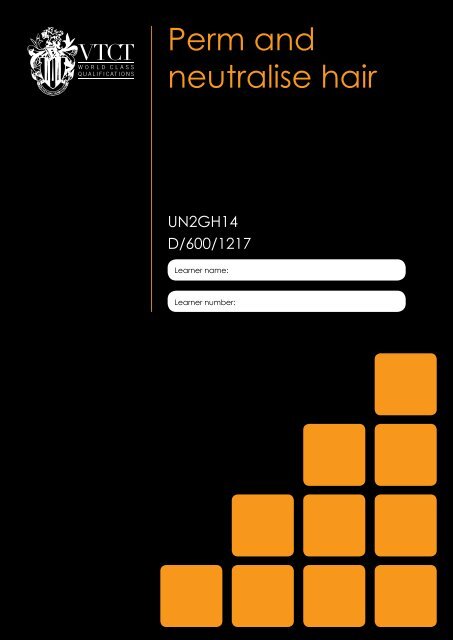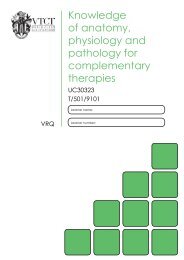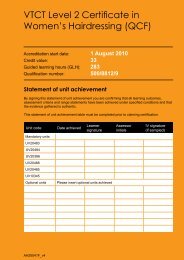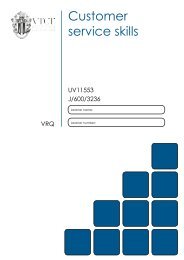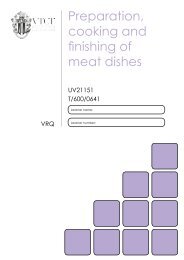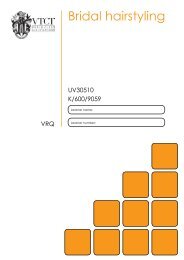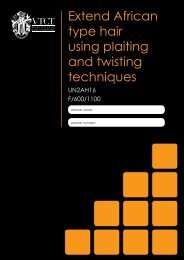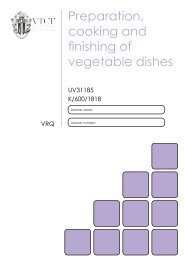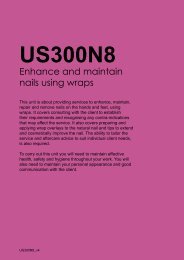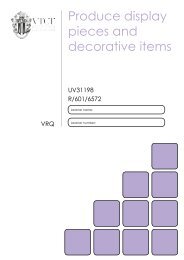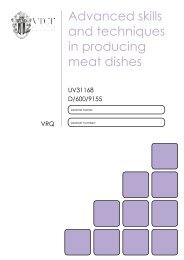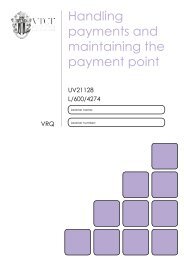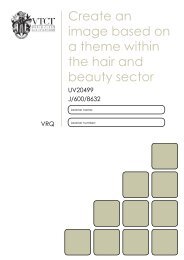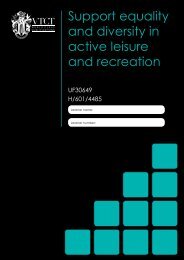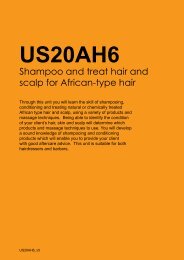Perm and neutralise hair - VTCT
Perm and neutralise hair - VTCT
Perm and neutralise hair - VTCT
You also want an ePaper? Increase the reach of your titles
YUMPU automatically turns print PDFs into web optimized ePapers that Google loves.
<strong>Perm</strong> <strong>and</strong><br />
<strong>neutralise</strong> <strong>hair</strong><br />
UN2GH14<br />
D/600/1217<br />
Learner name:<br />
Learner number:
Statement of unit achievement<br />
<strong>VTCT</strong> is the specialist awarding body for the Hairdressing, Beauty Therapy,<br />
Complementary Therapy <strong>and</strong> Sport <strong>and</strong> Active Leisure sectors, with over 45<br />
years of experience.<br />
<strong>VTCT</strong> is an awarding body regulated by national organisations including<br />
Ofqual, SQA, DCELLS <strong>and</strong> CCEA.<br />
<strong>VTCT</strong> is a registered charity investing in education <strong>and</strong> skills but also giving to<br />
good causes in the area of facial disfigurement.<br />
By signing this statement of unit achievement you are confirming that all learning outcomes, assessment<br />
criteria <strong>and</strong> range statements have been achieved under specified conditions <strong>and</strong> that the evidence<br />
gathered is authentic.<br />
This statement of unit achievement table must be completed prior to claiming certification.<br />
Unit code Date achieved Learner signature<br />
Assessor tracking table<br />
Assessor name Assessor signature<br />
Assessor<br />
initials<br />
Assessors<br />
initials<br />
IV signature<br />
(if sampled)<br />
All assessors using this Record of Assessment book must complete this table. This is required for<br />
verification purposes.<br />
Assessor number<br />
(optional)
UN2GH14<br />
<strong>Perm</strong> <strong>and</strong> <strong>neutralise</strong> <strong>hair</strong><br />
Through this unit you will learn how to develop your<br />
perm winding techniques to provide basic perming<br />
<strong>and</strong> neutralising services for your clients. Using these<br />
techniques you will demonstrate the three main sectioning<br />
winds which are directional, brick <strong>and</strong> ‘9’ section. Being<br />
able to identify the condition of your client’s <strong>hair</strong>, skin <strong>and</strong><br />
scalp will determine which products <strong>and</strong> technique to<br />
use. Part of this service is to provide your client with good<br />
aftercare advice. This unit is suitable for both <strong>hair</strong>dressers<br />
<strong>and</strong> barbers.<br />
UN2GH14_v6
NOS<br />
GH14<br />
Level<br />
Credit value<br />
GLH<br />
2<br />
8<br />
70<br />
Observations<br />
3<br />
External paper(s)<br />
1
<strong>Perm</strong> <strong>and</strong> <strong>neutralise</strong> <strong>hair</strong><br />
Learning outcomes Evidence requirements<br />
On completion of this unit you will:<br />
1. Be able to use effective <strong>and</strong> safe working<br />
methods when perming <strong>and</strong> neutralising<br />
<strong>hair</strong><br />
2. Be able to prepare for perming <strong>and</strong><br />
neutralising<br />
3. Be able to perm <strong>and</strong> <strong>neutralise</strong> <strong>hair</strong><br />
4. Know the salon <strong>and</strong> legal requirements<br />
5. Know how to work safely, effectively <strong>and</strong><br />
hygienically when perming <strong>and</strong> neutralising<br />
<strong>hair</strong><br />
6. Know about the use of testing for perming<br />
<strong>and</strong> neutralising services<br />
7. Know basic science for perming<br />
8. Know products, equipment <strong>and</strong> their use<br />
9. Know about perming <strong>and</strong> neutralising<br />
techniques <strong>and</strong> problems<br />
10. Know how to communicate <strong>and</strong> provide<br />
aftercare advice to clients<br />
1. Simulation is not allowed for any<br />
performance evidence within this unit.<br />
2. You must practically demonstrate in your<br />
everyday work that you have met the<br />
st<strong>and</strong>ard for perming <strong>and</strong> neutralising <strong>hair</strong><br />
3. Your assessor will observe these aspects of<br />
your performance on at least 3 occasions,<br />
of which 2 of the observed perms must<br />
be carried out on a full head.<br />
4. From the range, you must show that you<br />
have:<br />
• used all the products<br />
• questioned clients on all the areas of<br />
contra-indication<br />
• carried out all tests<br />
• taken into account all the factors<br />
• carried out all the types of sectioning<br />
techniques<br />
• given all the advice.<br />
5. It is likely most evidence of your<br />
performance will be gathered from the<br />
observations made by your assessor but<br />
you may be required to produce other<br />
evidence to support your performance if<br />
your assessor has not been present.<br />
6. Knowledge <strong>and</strong> underst<strong>and</strong>ing in this unit<br />
will be assessed by an external paper.<br />
The criteria that make up this paper are<br />
highlighted in white throughout this unit.<br />
There is one external paper that must be<br />
achieved.<br />
UN2GH14<br />
3
4<br />
Achieving observations<br />
<strong>and</strong> range<br />
Achieving observation outcomes<br />
Your assessor will observe your performance<br />
of practical tasks. The minimum number<br />
of observations required is indicated in the<br />
evidence requirements section of this unit.<br />
Criteria may not always naturally occur during<br />
a practical observation. In such instances you<br />
will be asked questions to demonstrate your<br />
competence in this area. Your assessor will<br />
document the criteria that have been achieved<br />
through oral questioning.<br />
Your assessor will sign off an outcome when all<br />
criteria have been competently achieved in a<br />
single client service.<br />
Achieving range<br />
The range section indicates what must<br />
be covered. Ranges must be practically<br />
demonstrated as part of an observation. Your<br />
assessor will document the portfolio reference<br />
once a range has been competently achieved.<br />
UN2GH14<br />
Maximum service times<br />
The following maximum service times apply to<br />
this unit:<br />
<strong>Perm</strong> winding only (all methods) 45 minutes
Outcome 1<br />
You can:<br />
a. Protect the client’s clothing throughout the<br />
service<br />
b. Use personal protective equipment when<br />
using perming <strong>and</strong> neutralising chemicals<br />
c. Clean <strong>and</strong> tidy the work area throughout the<br />
service<br />
d. Position client’s <strong>and</strong> adopt postures that<br />
minimise fatigue, discomfort <strong>and</strong> injury risk<br />
e. Use working methods that:<br />
- minimise the wastage of products<br />
- minimise the risk of cross-infection<br />
- make effective use of the working time<br />
- ensure the use of clean resources<br />
- minimise the risk of harm or injury to<br />
self <strong>and</strong> clients<br />
f. Maintain personal st<strong>and</strong>ards of health <strong>and</strong><br />
hygiene which minimise the risk of crossinfection,<br />
infestation <strong>and</strong> offence to your<br />
clients <strong>and</strong> colleagues<br />
g. Use tools <strong>and</strong> equipment that are safe <strong>and</strong><br />
fit for purpose<br />
*May be assessed through oral questioning.<br />
Observations<br />
Be able to use effective <strong>and</strong> safe working methods when<br />
perming <strong>and</strong> neutralising <strong>hair</strong><br />
h. Identify <strong>and</strong> report products that need reordering<br />
to the relevant person(s) *<br />
i. Complete the perming <strong>and</strong> neutralising<br />
service in a commercially viable time<br />
j. Remove waste immediately at the end of the<br />
perming <strong>and</strong> neutralising service<br />
k. Produce up to date client records at the end<br />
of the service<br />
Observation<br />
Criteria questioned orally<br />
Date achieved<br />
Portfolio reference<br />
Learner signature<br />
Assessor initials<br />
1 2 3<br />
UN2GH14<br />
5
6<br />
Outcome 2<br />
Be able to prepare for perming <strong>and</strong> neutralising<br />
You can:<br />
a. Use client questioning to identify contraindications<br />
to perming services <strong>and</strong> record<br />
the client’s responses<br />
b. Perform tests according to manufacturers’<br />
instructions <strong>and</strong> recognised industry<br />
procedures<br />
c. Record <strong>and</strong> interpret the outcomes of tests<br />
on the client’s record card<br />
d. Seek assistance from the relevant person(s)<br />
when contra-indications or reactions to tests<br />
indicate the service may be unsuitable for<br />
the client *<br />
e. Select products, tools <strong>and</strong> equipment based<br />
on the test results, client consultation <strong>and</strong><br />
other influencing factors<br />
f. Prepare products following manufacturers’<br />
instructions<br />
g. Protect the client’s <strong>hair</strong> <strong>and</strong> skin prior to<br />
perming <strong>and</strong> neutralising<br />
*May be assessed through oral questioning.<br />
Observation 1 2 3<br />
Criteria questioned orally<br />
Date achieved<br />
Portfolio reference<br />
Learner signature<br />
Assessor initials<br />
UN2GH14
Outcome 3<br />
Be able to perm <strong>and</strong> <strong>neutralise</strong> <strong>hair</strong><br />
You can:<br />
a. Use products <strong>and</strong> techniques taking into<br />
account influencing factors<br />
b. Use sectioning <strong>and</strong> winding techniques to<br />
achieve the desired look<br />
c. Secure any <strong>hair</strong> not being wound to keep<br />
the section clearly visible, when required *<br />
d. Use meshes of <strong>hair</strong> which suit the size of<br />
the perm rod<br />
e. Maintain tension throughout the winding<br />
process<br />
f. Position all wound perm rods so that they sit<br />
on their own base<br />
g. Follow manufacturers’ instructions<br />
accurately when:<br />
- applying perming lotion <strong>and</strong> <strong>neutralise</strong>rs<br />
to wound <strong>hair</strong><br />
- monitoring <strong>and</strong> timing the development of<br />
the perming <strong>and</strong> neutralising processes<br />
- applying suitable conditioners<br />
h. Perform development curl tests throughout<br />
the perming process to confirm the required<br />
degree of curl has been achieved<br />
*May be assessed through oral questioning.<br />
Observation 1 2 3<br />
Criteria questioned orally<br />
Date achieved<br />
Portfolio reference<br />
Learner signature<br />
Assessor initials<br />
i. Use <strong>and</strong> adapt water temperature <strong>and</strong> flow<br />
to meet the comfort needs of the client<br />
j. Remove perm lotion when the desired<br />
degree of curl is achieved<br />
k. Remove excess moisture before<br />
neutralising, without disturbing the wound<br />
<strong>hair</strong><br />
l. Remove the perm rods without disturbing<br />
the curl formation<br />
m. Check that the <strong>hair</strong> is free of <strong>neutralise</strong>r after<br />
the final rinse<br />
n. Identify <strong>and</strong> resolve problems during the<br />
perming <strong>and</strong> neutralising processes, within<br />
the limits of own authority *<br />
o. Refer problems that cannot be resolved to<br />
the relevant person(s) *<br />
p. Confirm the correct degree of curl is<br />
achieved for the final look<br />
q. Provide the client with suitable aftercare<br />
advice<br />
UN2GH14<br />
7
8<br />
Range<br />
You must practically demonstrate that you have:<br />
Used all the products Portfolio reference<br />
Barrier cream<br />
Pre-perm treatments<br />
<strong>Perm</strong> lotions<br />
Neutralisers<br />
Post-perm treatments<br />
Questioned clients on all the areas of contra-indication Portfolio reference<br />
History of previous allergic reaction to perming products<br />
Other known allergies<br />
Skin disorders<br />
Incompatible products<br />
Medical advice or instructions<br />
Carried out all tests Portfolio reference<br />
Elasticity<br />
Porosity<br />
Incompatibility<br />
Skin<br />
UN2GH14
You must practically demonstrate that you have:<br />
Taken into account all the factors Portfolio reference<br />
Temperature<br />
Direction <strong>and</strong> degree of movement required<br />
Hair condition<br />
Hair texture<br />
Hair length<br />
Hair density<br />
Carried out all the types of sectioning techniques Portfolio reference<br />
Directional<br />
Maximum service times – 45 mins<br />
9 section<br />
Maximum service times – 45 mins<br />
Brick<br />
Maximum service times – 45 mins<br />
Given all the advice Portfolio reference<br />
Suitable aftercare products <strong>and</strong> their use<br />
Use of heated styling equipment<br />
Time interval between services<br />
The effect of perming on other services<br />
UN2GH14 9
10<br />
Developing knowledge<br />
Achieving knowledge outcomes<br />
You will be guided by your tutor <strong>and</strong> assessor<br />
on the evidence that needs to be produced.<br />
Your knowledge <strong>and</strong> underst<strong>and</strong>ing will be<br />
assessed using the assessment methods listed<br />
below:<br />
• Observed work<br />
• Witness statements<br />
• Audio-visual media<br />
• Evidence of prior learning or attainment<br />
• Written questions<br />
• Oral questions<br />
• Assignments<br />
• Case studies<br />
Achieving the external paper<br />
UN2GH14<br />
Where possible your assessor will integrate<br />
knowledge outcomes into practical observations<br />
through oral questioning.<br />
The external paper will test your knowledge of the criteria highlighted in white. A pass mark of<br />
70% must be achieved. Criteria not achieved will be identified to your tutor/assessor. You will then<br />
be orally questioned or asked to produce other forms of evidence as all unit criteria must<br />
be achieved.<br />
Your assessor will complete the table below when the 70% pass mark has been achieved.<br />
Paper Date achieved Assessor initials<br />
1 of 1
Outcome 4<br />
Know the salon <strong>and</strong> legal requirements<br />
You can:<br />
a. Describe the salon's requirements for client preparation<br />
b. Describe the salon's expected service times for basic perming <strong>and</strong><br />
neutralising<br />
c. Describe when <strong>and</strong> how to complete client records<br />
d. Describe the salon’s <strong>and</strong> legal requirements for disposal of waste<br />
materials<br />
e. Outline own limits of authority for resolving perming <strong>and</strong><br />
neutralising problems<br />
f. State the person(s) to whom problems which cannot be resolved<br />
should be reported<br />
g. State personal responsibilities in relation to perming <strong>and</strong><br />
neutralising services under current legislation <strong>and</strong> regulations:<br />
- Data Protection legislation<br />
- Control of Substances Hazardous to Health Regulations<br />
- Electricity at Work Regulations<br />
* Assessor initials to be inserted if orally questioned.<br />
Requirements highlighted in white are assessed in the external paper.<br />
Knowledge<br />
Portfolio reference /<br />
Assessor initials*<br />
UN2GH14 11
12<br />
Outcome 5<br />
Know how to work safely, effectively <strong>and</strong> hygienically when<br />
perming <strong>and</strong> neutralising <strong>hair</strong><br />
You can:<br />
a. Describe the types of protective clothing <strong>and</strong> products that should<br />
be available for clients <strong>and</strong> yourself<br />
b. Describe types of personal protective equipment available <strong>and</strong><br />
their importance<br />
c. Define the condition contact dermatitis <strong>and</strong> how to avoid<br />
developing it whilst carrying out perming services<br />
d. Describe how self <strong>and</strong> client positioning can affect the desired<br />
outcome <strong>and</strong> reduce fatigue <strong>and</strong> injury risk<br />
e. Outline the safety considerations which must be taken into account<br />
when perming <strong>and</strong> neutralising <strong>hair</strong><br />
f. Describe why it is important to keep the work area clean <strong>and</strong> tidy<br />
g. Compare safe <strong>and</strong> hygienic working methods that minimise the<br />
risk of cross-infection <strong>and</strong> cross-infestation<br />
h. Describe why it is important to position tools <strong>and</strong> equipment for<br />
ease of use<br />
i. Outline the importance of personal hygiene<br />
j. Describe how <strong>and</strong> why it is important to check electrical equipment<br />
used to aid the perming process<br />
k. Clarify the importance <strong>and</strong> legal significance of questioning clients<br />
to identify contra-indications to perming <strong>and</strong> of recording client<br />
responses<br />
* Assessor initials to be inserted if orally questioned.<br />
Requirements highlighted in white are assessed in the external paper.<br />
UN2GH14<br />
Portfolio reference /<br />
Assessor initials*
Outcome 6<br />
Know about the use of testing for perming <strong>and</strong> neutralising<br />
services<br />
You can:<br />
a. Describe the types <strong>and</strong> purposes of tests used for perming <strong>and</strong><br />
neutralising services<br />
b. State when <strong>and</strong> how tests should be carried out <strong>and</strong> the expected<br />
results<br />
c. Describe how the results of tests can influence the perming service<br />
d. Describe the potential consequences of failing to test<br />
e. Outline the courses of action to take in the event of adverse<br />
reactions to tests<br />
f. Describe why it is important to record test results<br />
* Assessor initials to be inserted if orally questioned.<br />
Requirements highlighted in white are assessed in the external paper.<br />
Portfolio reference /<br />
Assessor initials*<br />
UN2GH14 13
14<br />
Outcome 7<br />
Know basic science for perming<br />
You can:<br />
a. Describe the effects of perm lotions <strong>and</strong> <strong>neutralise</strong>rs on <strong>hair</strong><br />
structure<br />
b. Describe how temperature affects the perming process<br />
c. Outline the importance of accurate timing <strong>and</strong> thorough rinsing of<br />
products<br />
d. Outline the importance <strong>and</strong> effects of restoring the <strong>hair</strong>’s pH<br />
balance after the perming <strong>and</strong> neutralising process<br />
e. Outline the importance of water temperature during the neutralising<br />
process<br />
f. Describe how different factors can affect the choice of perming <strong>and</strong><br />
neutralising products<br />
g. Describe how <strong>and</strong> why contra-indications can affect the delivery of<br />
perming services<br />
* Assessor initials to be inserted if orally questioned.<br />
Requirements highlighted in white are assessed in the external paper.<br />
UN2GH14<br />
Portfolio reference /<br />
Assessor initials*
Outcome 8<br />
Know products, equipment <strong>and</strong> their use<br />
You can:<br />
a. Describe the types of equipment used during the perm<br />
development process<br />
b. Outline the importance of following the manufacturers’ instructions<br />
for perming <strong>and</strong> neutralising products in the salon<br />
c. Describe when <strong>and</strong> why it is important to use pre-perm treatments<br />
d. Compare the different types <strong>and</strong> uses of available perm lotions,<br />
<strong>neutralise</strong>rs <strong>and</strong> post-perm conditioners<br />
e. Outline the importance of using products economically<br />
* Assessor initials to be inserted if orally questioned.<br />
Requirements highlighted in white are assessed in the external paper.<br />
Portfolio reference /<br />
Assessor initials*<br />
UN2GH14 15
16<br />
Outcome 9<br />
Know about perming <strong>and</strong> neutralising techniques <strong>and</strong><br />
problems<br />
You can:<br />
a. Describe when to use different types of sectioning techniques <strong>and</strong><br />
why<br />
b. Describe the factors that influence the use of different sized perm<br />
rods<br />
c. Describe the method of checking curl development<br />
d. Describe methods of application of perming lotions <strong>and</strong><br />
neutralising agents<br />
e. Describe the types <strong>and</strong> causes of problems during the perming<br />
<strong>and</strong> neutralising processes<br />
f. Describe methods of resolving perming problems<br />
* Assessor initials to be inserted if orally questioned.<br />
Requirements highlighted in white are assessed in the external paper.<br />
UN2GH14<br />
Portfolio reference /<br />
Assessor initials*
Outcome 10<br />
Know how to communicate <strong>and</strong> provide aftercare advice to<br />
clients<br />
You can:<br />
a. Describe beneficial <strong>and</strong> unsuitable home products for use by the<br />
client<br />
b. Describe how the continual use of heated equipment can affect<br />
permed <strong>hair</strong><br />
c. Estimate recommended time intervals between perming <strong>and</strong> other<br />
services<br />
d. Describe how lifestyle factors can affect the <strong>hair</strong><br />
e. Describe how perming can affect other services<br />
f. Describe how to give effective advice <strong>and</strong> recommendations to<br />
clients<br />
* Assessor initials to be inserted if orally questioned.<br />
Requirements highlighted in white are assessed in the external paper.<br />
Portfolio reference /<br />
Assessor initials*<br />
UN2GH14 17
18<br />
UN2GH14<br />
Notes<br />
Use this area for making notes <strong>and</strong> drawing diagrams


